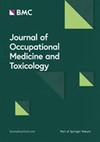Pulmonary function assessment after COVID-19 in vaccinated healthcare workers
IF 2.7
4区 医学
Q2 PUBLIC, ENVIRONMENTAL & OCCUPATIONAL HEALTH
Journal of Occupational Medicine and Toxicology
Pub Date : 2023-12-15
DOI:10.1186/s12995-023-00400-7
引用次数: 0
Abstract
COVID-19 typically presents with flu-like symptoms due to the viral infection itself. The most severe cases are characterised by lung damage, an important factor in fatal outcome due to alveolar damage. In some cases, patients develop a long COVID with persistent symptoms of chest pain and fatigue. Causes, including organ damage or inflammation, are being investigated. Clinical outcomes are variable and permanent lung damage is not fully understood, while vaccination is effective against severe infection but its effect on respiratory function in mild cases remains uncertain. This retrospective study aims to analyse changes in lung function in HCWs who had COVID-19 between 2020 and 2022, comparing their spirometric test results before and after the pandemic and taking into account their vaccination status. 321 HCWs were included in the study. The study examined spirometric parameters both before and after the pandemic, and all measured outcomes except the FEV1/FVC ratio showed a significant decrease during the study period. We then assessed the association between SARS-CoV-2 infection and changes in lung function parameters, analysing infections in 2020, 2021 and 2022 separately. We found a statistically significant difference in Forced vital capacity (FVC) between infected and non-infected subjects in 2020 and 2021, but not in 2022. To evaluate the protective effect of SARS-CoV-2 vaccination on respiratory function, a linear regression analysis was performed using changes in FVC, Forced expiratory volume in 1 s (FEV1), FVC/FEV1 ratio and Peak expiratory flow (PEF) as dependent variables. The analysis showed that the decline in FVC was significantly lower in subjects who had been vaccinated prior to infection. The study concludes that subclinical SARS-CoV-2 infections in 2020 and 2021 worsened respiratory parameters (FVC and FEV1), but vaccination protected against these effects. Even healthy individuals with previous infections showed respiratory changes, with vaccination providing protection, especially for FVC decline. This highlights the importance of vaccinating healthcare workers against COVID-19.对接种 COVID-19 疫苗的医护人员进行肺功能评估
由于病毒感染本身的原因,COVID-19 通常会出现类似流感的症状。最严重的病例以肺部损伤为特征,肺泡损伤是导致死亡的重要因素。在某些病例中,患者会出现长期的 COVID,并伴有持续的胸痛和疲劳症状。目前正在研究其原因,包括器官损伤或炎症。临床结果不尽相同,永久性肺损伤尚未完全明了,而疫苗接种对严重感染有效,但对轻症病例呼吸功能的影响仍不确定。这项回顾性研究旨在分析 2020 年至 2022 年期间接种 COVID-19 的高危工人肺功能的变化,比较他们在大流行前后的肺功能测试结果,并考虑他们的疫苗接种情况。研究共纳入了 321 名医护人员。研究对大流行前后的肺活量参数进行了检测,除 FEV1/FVC 比值外,所有测量结果在研究期间都出现了显著下降。然后,我们评估了 SARS-CoV-2 感染与肺功能参数变化之间的关联,分别分析了 2020 年、2021 年和 2022 年的感染情况。我们发现,在 2020 年和 2021 年,感染者和非感染者的用力肺活量(FVC)有明显的统计学差异,但在 2022 年则没有。为了评估接种 SARS-CoV-2 疫苗对呼吸功能的保护作用,我们以 FVC、1 秒内用力呼气容积 (FEV1)、FVC/FEV1 比率和呼气峰流速 (PEF) 的变化作为因变量,进行了线性回归分析。分析结果显示,在感染前接种过疫苗的受试者的 FVC 下降幅度明显较低。该研究得出结论,2020 年和 2021 年的亚临床 SARS-CoV-2 感染会使呼吸参数(FVC 和 FEV1)恶化,但接种疫苗可抵御这些影响。即使是既往感染过SARS-CoV-2的健康人也会出现呼吸系统变化,而接种疫苗则能提供保护,尤其是在FVC下降方面。这凸显了医护人员接种 COVID-19 疫苗的重要性。
本文章由计算机程序翻译,如有差异,请以英文原文为准。
求助全文
约1分钟内获得全文
求助全文
来源期刊

Journal of Occupational Medicine and Toxicology
PUBLIC, ENVIRONMENTAL & OCCUPATIONAL HEALTH-
CiteScore
6.00
自引率
0.00%
发文量
23
审稿时长
19 weeks
期刊介绍:
Aimed at clinicians and researchers, the Journal of Occupational Medicine and Toxicology is a multi-disciplinary, open access journal which publishes original research on the clinical and scientific aspects of occupational and environmental health.
With high-quality peer review and quick decision times, we welcome submissions on the diagnosis, prevention, management, and scientific analysis of occupational diseases, injuries, and disability. The journal also covers the promotion of health of workers, their families, and communities, and ranges from rehabilitation to tropical medicine and public health aspects.
 求助内容:
求助内容: 应助结果提醒方式:
应助结果提醒方式:


